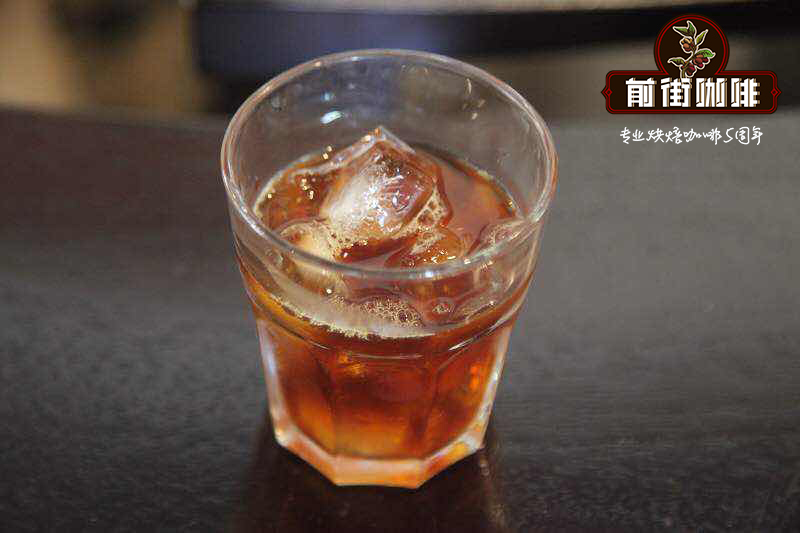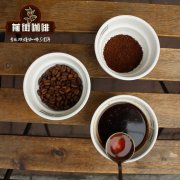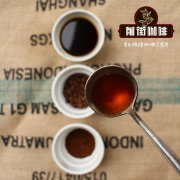Indonesia Sulawesi Wet planing | Tonaga Toraja Bina lestari Coffee Flavor and brewing

Professional coffee knowledge exchange more coffee bean information please follow the coffee workshop (Wechat official account cafe_style)
Indonesia Sulawesi wet planing method | Tonaga Toraja Bina lestari coffee flavor and brewing?
Indonesia is the largest archipelago country in the world. Arabica tree species coffee was introduced and planted during the Dutch rule in the 18th century. The main producing areas are in Sumatra, Java and Sulawesi. Mantenin's deep, low-acidity and rich taste makes people call it the 'most important coffee in the world'. It is also the fourth largest producer in the world with an annual output of 7 million bags. Coffee is harvested twice a year from May to June and from September to October, with the highest production in Sumatra and Aceh. The scale of the coffee farm is not about 1-3 hectares. Mantenin coffee treatment in Indonesia generally adopts semi-washing method. Coffee farmers harvest ripe coffee beans, remove the external peel and pulp but retain the thin film tissue on the coffee beans, and remove the bad beans that do not bear fruit and float on the water surface through the process of immersion and fermentation, while the strong and sunken beans can be sunlit or directly to the ground with the surface film. Finally, a dryer is used to make the moisture content reach a unified standard. The most unique thing is to use parchment to cover coffee beans with a thin film to maintain a moisture content of 18%. Before shipment, the coffee bean surface film is polished and cleaned. The world calls this section of the special treatment method called Indonesian-style semi-washing method, large coffee processing plants can accurately control each treatment process, flavor and taste has a certain level. On the other hand, small coffee farmers treat raw beans in their own yard, and the flavor will vary according to the handling methods and skills of different coffee farmers.
Indonesia straddles both sides of the equator, the hot and humid rainforest climate is rich in rainfall, and the fertile volcanic soil brings rich nutrients to coffee.
Sulawesi of Sulawesi, formerly known as Celebes, is one of the oldest islands in the Indonesian archipelago. Sulawesi, Java and Sumatra all belong to volcanic topography. The most famous coffee producing areas are in the Tana Toraja highlands, located in the mountains of South Sulawesi. The coffee forest region is 1300,000m above sea level, with plenty of sunshine and a large temperature difference between day and night. The normal temperature is maintained at 24 ℃-25 ℃. Coupled with the rich nutrients of the volcanic soil in the fertile tropical highlands, it is the height most suitable for the growth of Indonesia's high-quality Arabica bean coffee forest. Coffee beans from the Toraja highlands of Sulawesi, Indonesia, are another generation of high-quality coffee. With a small annual output and the elegant characteristics of high mountain beans, they are famous for their full consistency and rich flavor. They are often the favorite choice of the Indonesian royal family and European royal aristocracy, and a delicate choice of Asian beans.
The coffee produced in Sulawesi, Indonesia's third largest island, accounts for only 9% of Indonesia's coffee production each year. Coffee grows in the rainforest of 750-1500 meters above sea level. Most of the high-quality coffee is grown around the Toraja platform in the southwest. Tonaga is located at an altitude of 1500 meters above sea level on the equatorial belt shrouded with rain and clouds in the afternoon. Coupled with the fertile volcanic soil, these are the best natural climate and environment for coffee growth. Most Indonesian coffee is sold, sold and exported by local coffee companies. Direct coffee has been introduced to small-scale Binalestari coffee merchants in Sulawesi Tonaga. Coffee is several grades G1 in Arabica, and the color of raw coffee beans is long rice-shaped and bright emerald green. Different from the yellowish brown of gold manning and Sumatra manning (compared with photos on the blog), and there are fewer defective beans and poorly fermented white beans, it is a good coffee on a small estate with a less disturbing smell of soil.
In 1699, the East India Company (Verininging Oogst-Indies Company) introduced Arabica coffee to Indonesia, which was a Dutch colony at the time. In 1711, the first batch of coffee was exported from Java to Europe by the East India Company, breaking the Arab monopoly of coffee trade in the world. Indonesia became the first place in the world to grow coffee outside Arabian Peninsula and Ethiopia, and the East India Company also monopolized the coffee market from 1725 to 1780. The Dutch colonial government originally planted coffee around Batavia (now Jakarta), and most of the coffee growing areas were in Java.
In parts of Sumatra and Sulawesi, the coffee industry in Sulawesi began to take root in 1750. Sulawesi, named after Celebes in the Dutch colonial era, was renamed Sulawesi because it was rich in iron ore in its early days. It is one of the top four islands in Indonesia, the Thousand Islands. Sulawesi's coffee production mainly comes from the Tana Toraja Highlands on the southwest-central side of the island, with towering terrain, and because of the hot and humid climate on both sides of the equator, coupled with the rich nutrients of volcanic soil, there are good innate conditions for coffee cultivation.
Toraja is the family name of the local aboriginal people and is the main coffee grower in the area, but for these small coffee farmers, due to the rugged terrain and poor economic conditions, the harvested coffee cherries are usually transported to the distribution centers in the east (Sapan) or west of the island (Minanga or Kolosi), where they are processed and sold through mid-market merchants or processing plants.
Local traditional wet stripping (Giling Basah) treatment of Toraja, green beans, good tidiness, in addition to the low acidity of Indonesian coffee, soft and mellow taste, and with dark chocolate and longan dry fruit tone. Sulawesi Tonaga (Toraja) has the label "Bina lestari" on the coffee bean bag.
Coffee tree species is Arabica, the best grade is G1 grade beans (G2.G3 in order), coffee has perfect long rice type.
Shallow baking: after grinding the beans, there is a clear taste of fairy grass, the special aroma of ginseng and licorice is not disturbing earthy and fishy smell, the taste is clean, light and complex, not bright citrus acid and sweet honey, the aftertaste has the aroma and tea feeling of alpine oolong tea.
Re-roasting: the coffee has the aroma of creamy popcorn after grinding, the sweetness of dark chocolate after brewing, the complex aroma and smooth ester taste, and the sweetness of longan honey and brown sugar in the aftertaste.
If the Sulawesi Tonaga coffee is roasted to a slightly strong to strong flavor, it has a rich maltose taste and a low herbal flavor of Indonesian mantenin, which is very different from light roasting and is a great choice on a par with golden manning.
Sulawesi Tonaga also maintains the ancient traditional mode of production in Indonesia. Small-area coffee farms also have washed, dried and semi-washed coffee beans, which is the most special area of all Indonesian coffee beans. although his concentration is not as thick as Sumatra Mantenin, it has a little more smoothness and less earthy and mushroom flavor. The acidity also improves and leaves a refreshing fruity flavor.
Filter cup: Hario V60
Water temperature: 90 degrees
Degree of grinding: small Fuji 3.5
Cooking methods: the ratio of water to powder is 1:15, 15g powder, the first injection of 25g water, 25 s steaming, the second injection to 120g water cut off, waiting for the powder bed water to half and then water injection, slow water injection until 225g water, extraction time about 2:00
Analysis: using three-stage brewing to clarify the flavor of the front, middle and back of the coffee. Because V60 has many ribs and the drainage speed is fast, it can prolong the extraction time when the water is cut off.
Important Notice :
前街咖啡 FrontStreet Coffee has moved to new addredd:
FrontStreet Coffee Address: 315,Donghua East Road,GuangZhou
Tel:020 38364473
- Prev

East of the Baru volcano in the Pokuit producing area of Panama | Emporium Estate Empolian Manor in the sun
Professional coffee knowledge exchange more coffee bean information please follow the coffee workshop (Wechat official account cafe_style) Panama Pokuit producing area east of the Baru volcano | Emporium Estate Empolian Manor Sun Bean flavor? For a long time in coffee history, Panamanian coffee was underestimated or even ignored, until the annual international cup test competition held in recent years, Panama.
- Next

King of Indonesia | Sulawesi of Sulawesi Island washes the wind of the "reborn Kebangkitan" variety
Professional coffee knowledge exchange more coffee bean information please follow the coffee workshop (Wechat official account cafe_style) King of Indonesia | Sulawesi Island Sulawesi fully washed reborn Kebangkitan flavor characteristics? Sulawesi (Celebes/slbiz/) is a large island in eastern Indonesia. The main producing areas are: Mamasa, Tana To
Related
- Detailed explanation of Jadeite planting Land in Panamanian Jadeite Manor introduction to the grading system of Jadeite competitive bidding, Red bid, Green bid and Rose Summer
- Story of Coffee planting in Brenka region of Costa Rica Stonehenge Manor anaerobic heavy honey treatment of flavor mouth
- What's on the barrel of Blue Mountain Coffee beans?
- Can American coffee also pull flowers? How to use hot American style to pull out a good-looking pattern?
- Can you make a cold extract with coffee beans? What is the right proportion for cold-extracted coffee formula?
- Indonesian PWN Gold Mandrine Coffee Origin Features Flavor How to Chong? Mandolin coffee is American.
- A brief introduction to the flavor characteristics of Brazilian yellow bourbon coffee beans
- What is the effect of different water quality on the flavor of cold-extracted coffee? What kind of water is best for brewing coffee?
- Why do you think of Rose Summer whenever you mention Panamanian coffee?
- Introduction to the characteristics of authentic blue mountain coffee bean producing areas? What is the CIB Coffee Authority in Jamaica?

